Walking into your home, a lush green oasis can feel like a calm retreat. Small indoor plants can turn any room into a vibrant, refreshing space. They’re great for both experienced plant lovers and newbies looking for easy-care options.
Picture your office or living room with Snake Plants, ZZ Plants, or Pothos hanging around. These plants make your space look better and offer many benefits. They clean the air and can even lift your mood. Plus, they do well in different light levels, making them perfect for busy people and rooms with little sunlight.
Table of Contents
The Benefits of Having Small Indoor Plants
Introduce the fresh, revitalizing essence of nature into your space with small indoor plants. These compact, low-maintenance plants offer many benefits. They can change the ambiance and improve your well-being.
Improve Air Quality
Indoor plants act as natural air purifiers, removing pollutants like formaldehyde and benzene. Air-purifying plants like the Snake Plant and Pothos are known for improving indoor air quality. They help create a healthier environment.
Enhance Mood and Creativity
Being around mood-boosting plants can deeply affect your mental state. Studies show that caring for indoor plants can lower stress, enhance focus, and increase productivity. They are great for any office or home.
Space-Saving Solutions
Compact plants are ideal for small spaces, fitting well on desks, shelves, or windowsills. These space-saving plants bring nature’s beauty into your life, regardless of your space size.
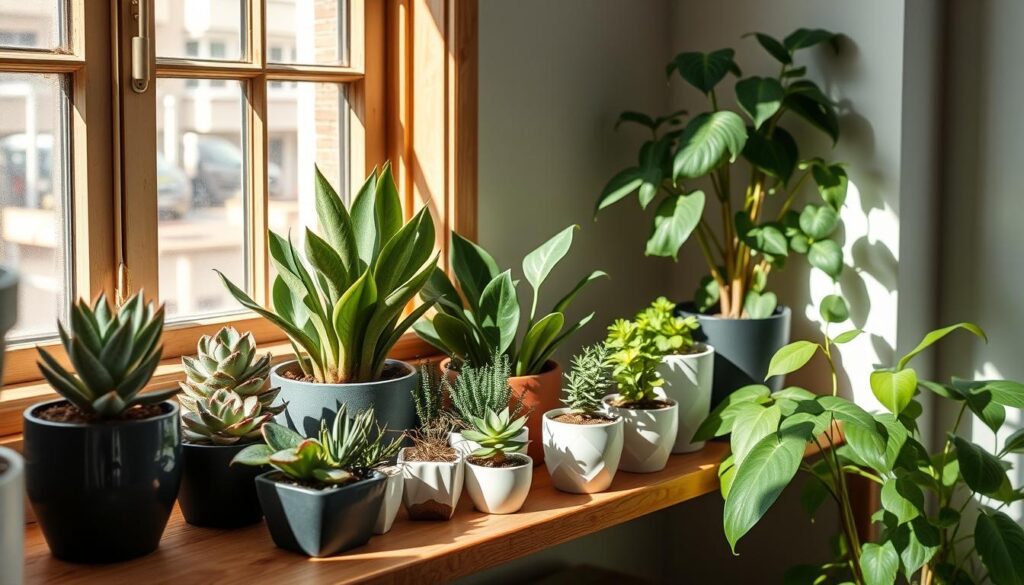
“Houseplants are a simple way to improve the air quality, mood, and overall ambiance of any indoor space.”
Looking to purify the air, boost creativity, or find a space-saving solution? Small indoor plants offer many benefits. They can transform your environment and improve your well-being.
Top Low-Maintenance Small Indoor Plants
Bringing nature indoors can make any space feel alive. But, keeping an indoor garden can seem hard. Luckily, there are many drought-tolerant plants and low-maintenance plants that do well in small spaces. They need little care, making them great for busy people or those new to indoor gardening.
Snake Plant
The Snake Plant (Dracaena trifasciata) is a top pick for those who want easy-care plants. It can handle neglect and low light, needing water only sometimes. Snake plants fit well in many homes, perfect for those who forget to water.
ZZ Plant
The ZZ Plant (Zamioculcas zamiifolia) is almost impossible to kill. It loves neglect, low light, and can go without water for a long time. It’s a great choice for those who want low-maintenance plants that can handle different conditions.
Pothos
The Pothos (Epipremnum aureum) is a great choice for beginners. It can grow in various light conditions. This easy-care plant needs little care and can clean the air in your home or office.
These drought-tolerant plants and low-maintenance plants are perfect for adding greenery without the hassle. They are tough and can do well even if you forget to care for them.
“Having plants in your home or office can lead to feeling more comfortable, soothed, and natural, improving overall well-being.” – Journal of Physiological Anthropology
Choosing the Right Location for Your Plants
Creating an indoor oasis with small plants starts with the right spot. The location you choose can greatly affect your plants’ health. Let’s look at the important factors for indoor plant placement, plant light requirements, and ideal plant conditions.
Lighting Considerations
Most small indoor plants love bright, indirect light. Direct sunlight can harm their leaves. So, place them in well-lit spots, like near windows or under skylights, for filtered natural light.
If your space has little natural light, use energy-efficient grow lights. They help meet your plants’ plant light requirements.
Temperature and Humidity
Keeping the right temperature and humidity is key for your plants’ health. Aim for a temperature between 60°F and 75°F (15°C and 24°C). Stay away from drafty areas and extreme temperature changes.
Also, moderate humidity is best. Group plants together or use a pebble tray to boost air moisture.
Proximity to Maintenance
Think about how easy it is to care for your plants when choosing their spot. Place them near a water source, like a sink, for easy watering. Group plants with similar needs together to simplify care.
By carefully considering these factors, you can create a perfect environment for your small indoor plants. This will help them thrive and add a natural touch to your home.
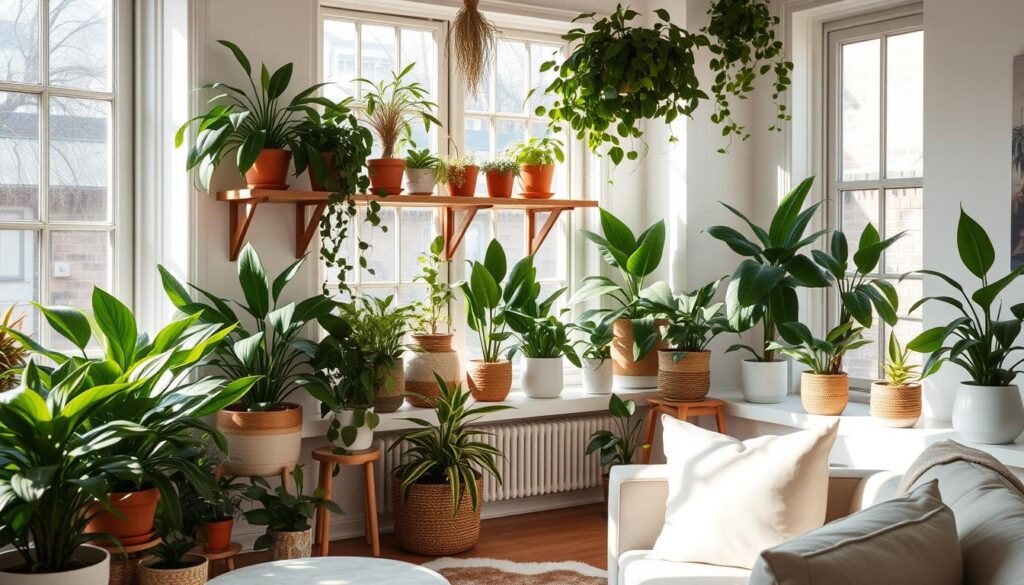
How to Care for Small Indoor Plants
Caring for small indoor plants is all about finding the right balance. You need to give them the right amount of water, nutrients, and maintenance. By following a few simple tips, you can keep your plants happy and healthy for years.
Watering Tips
Watering your indoor plants is key. You should avoid over-watering and under-watering. Water your plants when the top inch of soil feels dry to the touch.
How often you need to water depends on the plant’s size and type. It might be every one to two weeks. Always check the soil moisture and adjust your watering schedule as needed.
Fertilization Guide
Most small indoor plants need regular fertilization during the growing season. This is usually spring and summer. Use a balanced, water-soluble fertilizer and follow the product instructions, usually every two to four weeks.
Don’t over-fertilize, as it can cause problems like burnt leaf tips. It’s better to be safe than sorry.
Pruning and Repotting
Pruning your indoor plants helps them grow well. Trim any dead or damaged leaves or stems. Light pruning can also help control their size and shape.
Repotting is also important. Plants grow out of their containers over time. Transplant them to a slightly larger pot with fresh potting soil every one to two years.
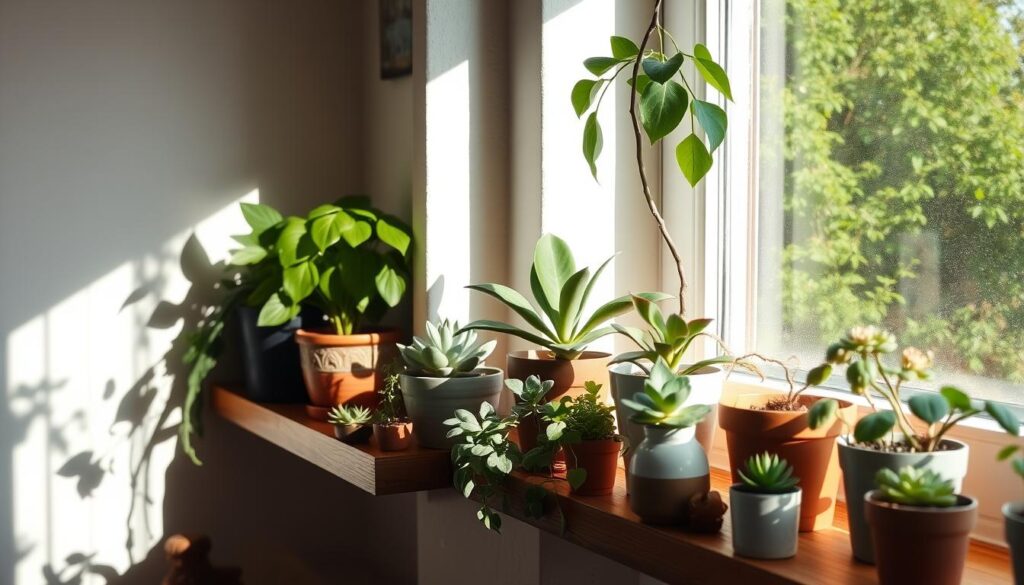
By following these plant care tips, you can ensure your small indoor plants get the right watering and fertilizing. With a little care, these low-maintenance houseplants can add life, beauty, and air-purifying benefits to your home or office.
Stylish Pots and Planters for Small Spaces
Make your indoor plants stand out with the right pots and planters. You can find modern designs and eco-friendly materials. These options will enhance your decor and make the most of small spaces.
Modern Designs
Go for sleek, minimalist looks with ceramic pots in geometric shapes and metallic finishes. These modern designs mix style and practicality. They give your small indoor plant pots a chic, polished vibe.
Eco-Friendly Materials
Choose small planters made from recycled plastic, bamboo, or biodegradable materials. These eco-friendly choices are good for the planet. They also bring a natural, organic feel to your indoor plant containers.
Size and Drainage Options
Think about the size and drainage needs of your plants when picking small pots. Make sure the containers have holes for water to drain or use pebbles at the bottom. Self-watering planters are great for those who don’t have much time to care for plants.
Use hanging planters or wall-mounted containers to save floor space. The right pots and planters can turn your small space into a beautiful, functional indoor garden. It will match your unique style perfectly.
“Stylish outdoor planters can spruce up any space for summer lounging and entertaining.”
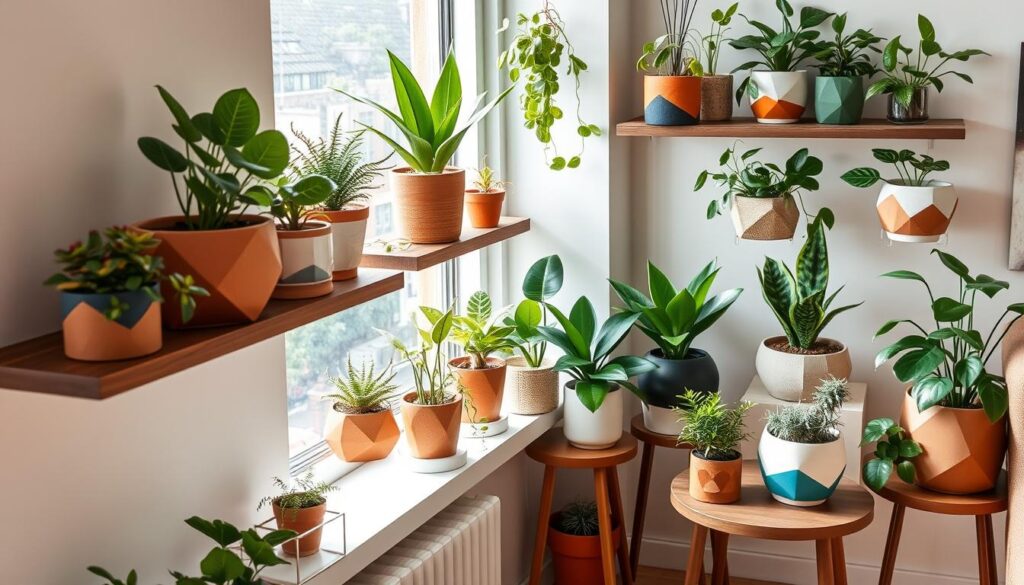
Common Pests and Diseases to Watch For
Keeping small indoor plants healthy means watching out for pests and diseases. You might see spider mites or mealybugs. Knowing how to spot and stop these problems is key to keeping your plants well.
Identifying Common Issues
Look for signs like webbing, white fuzzy spots, or small flying bugs. Spider mites are tiny but can multiply fast. Thrips, fungus gnats, and whiteflies also harm plants.
Diseases show up as leaf spots, wilting, or yellowing. Mealybugs are especially hard to deal with because of their wax coating and quick breeding.
Treatment Solutions
- Use insecticidal soap or neem oil to treat pests.
- Remove sick parts to stop disease spread.
- Improve air flow to fight fungal problems.
- For mealybugs, use isopropyl alcohol or dish soap. Systemic insecticides might be needed for bad cases.
Preventative Measures
- Water plants right to avoid disease.
- Check your plants often, especially new ones.
- Quarantine new plants before adding them to your collection.
By being careful and taking action early, you can keep your plants healthy. With the right care, these plants will bring joy and beauty to your space.
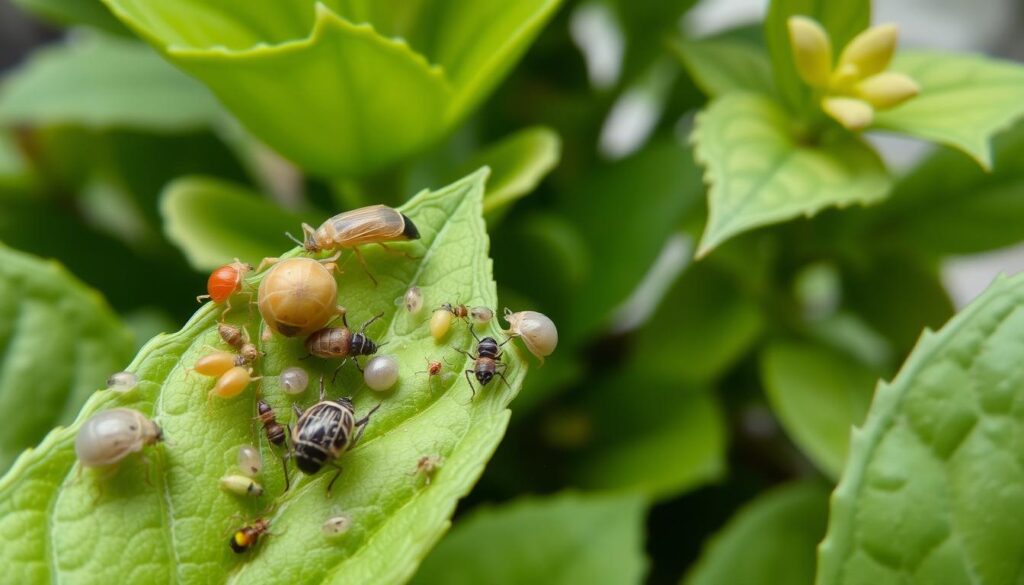
Expert Tips for Decorating with Small Indoor Plants
Add small indoor plants to your home decor for a stylish touch. These plants can fit right in with your furniture, adding a chic vibe. They can also be the main attraction in a room. Mixing plants with your decor creates stunning, cohesive spaces that show off your style.
Combining Plants with Decor
Place small indoor plants with your furniture and accessories for a fresh look. They can brighten up shelves, side tables, or windowsills. Try different plant sizes and types to make a beautiful display.
Grouping Techniques
- Cluster plants of varying heights and textures together for a lush, layered look.
- Arrange plants in odd-numbered groups, such as three or five, to create a sense of balance and visual interest.
- Mix and match plant types, such as succulents, ferns, and flowering plants, to add depth and variety to your display.
Seasonal Decoration Ideas
Add seasonal flair to your indoor plants with new planters or holiday accents. Use festive pots or add natural elements like pinecones in winter. Change your plants to match the seasons, showing off blooms or foliage that fit the time of year.
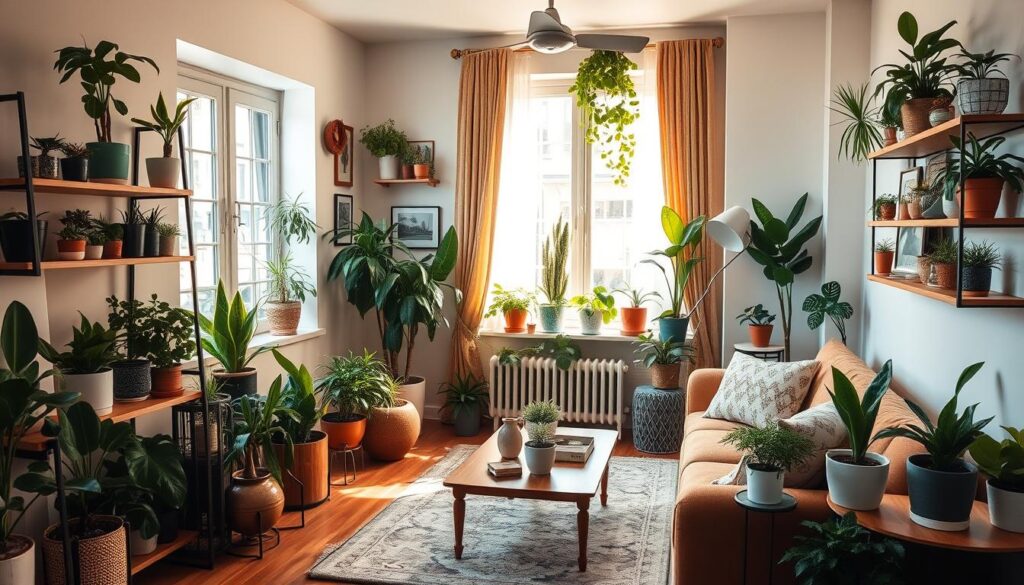
Follow these tips to easily add small indoor plants to your decor. They make your space lush and stylish, showing off your taste. Try different setups and seasonal touches to refresh your home.
Creative Ideas for Plant Displays
Turn your home into a lush oasis with these creative plant display ideas. You can use vertical gardens or hanging planters to add natural beauty. These methods save space and make your home look great.
Shelving and Vertical Gardens
Use floating or ladder shelves for a cool vertical garden. Place low-care plants like snake plants or ZZ plants in a neat layout. This is great for small spaces or tight rooms.
Hanging Planters
Hang plants from the ceiling with macramé hangers or baskets. Plants like pothos or English ivy look great hanging. They add a fun touch and bring greenery to new spots in your home.
Table Centerpieces
Make your dining or coffee table a green oasis with small plants. Choose plants that like low light, like philodendrons or inch plants. Put them in bowls, trays, or even old teacups and mason jars. This easy centerpiece refreshes your space.
Try mixing different plants, textures, and heights for stunning displays. Whether you like modern or lush looks, these ideas will make your home vibrant.
“Bringing the outdoors in through creative plant displays not only enhances the aesthetic of a room but also promotes a sense of calm and well-being.” – Interior Design Magazine
Final Thoughts on Small Indoor Plants
Small indoor plants can make your home feel fresher and more lively. They improve the air quality and boost your mood and creativity. Whether you’re new to plants or have been growing them for years, there’s a perfect small plant for you.
Summary of Top Picks
The Snake Plant, ZZ Plant, and Pothos are great for beginners. They’re easy to care for and can handle different light conditions. Plus, they need very little water, perfect for those with busy lives.
Encouragement to Start Planting
Start with just a few plants and add more as you get more comfortable. Try out different types to see what works best for you. Watching your plants grow is incredibly rewarding and can make your daily life better.
Resources for Further Learning
If you want to learn more about indoor gardening, there are many resources available. You can find online guides, local gardening groups, and more. These can help you learn about watering, dealing with pests, and even how to display your plants creatively.
FAQ
What are the benefits of having small indoor plants?
Small indoor plants improve air quality and mood. They also save space. These plants filter toxins, produce oxygen, and boost productivity.
What are some top low-maintenance small indoor plant options?
The Snake Plant, ZZ Plant, and Pothos are great choices. They thrive in low light and can handle neglect.
How much light do small indoor plants need?
Most small indoor plants prefer bright, indirect light. Direct sunlight can harm them. Place them where they get the right amount of light.
How often should I water my small indoor plants?
Water when the top inch of soil is dry. Don’t overwater to prevent root rot. Deep watering is better than frequent shallow watering.
How can I decorate with small indoor plants?
Be creative with your plant displays! Use shelves, hanging planters, or terrariums. Mix plants of different heights and textures. Rotate them seasonally for a new look.
How do I prevent pests and diseases on my small indoor plants?
To prevent pests and diseases, water correctly and avoid overwatering. Regularly check your plants. Use insecticidal soap or neem oil for problems. Quarantine new plants before adding them to your collection.
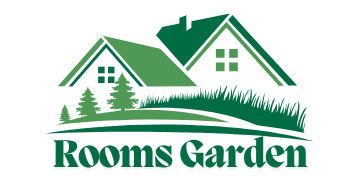
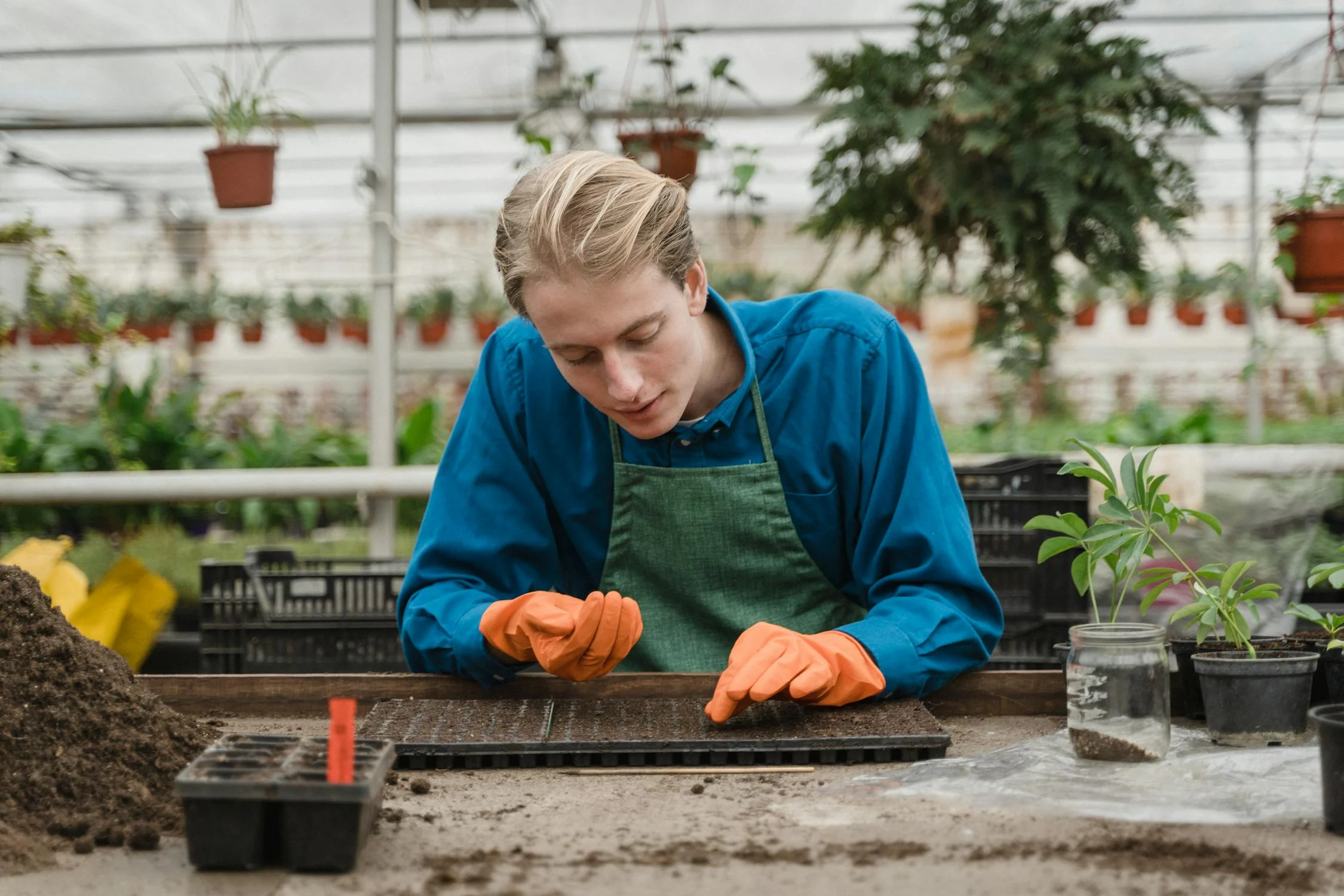
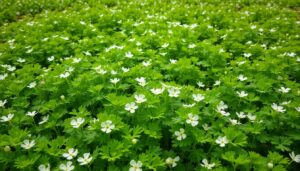
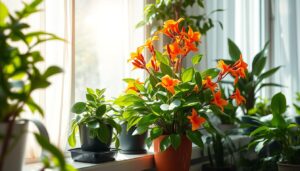

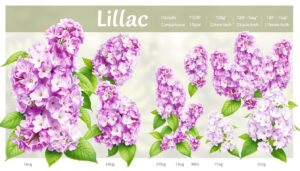
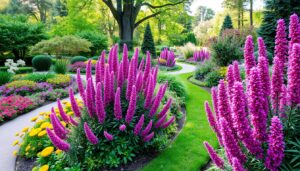


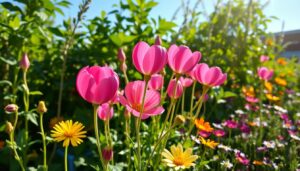
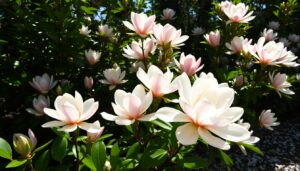
1 thought on “Best Small Indoor Plants: Top Low-Maintenance Picks”